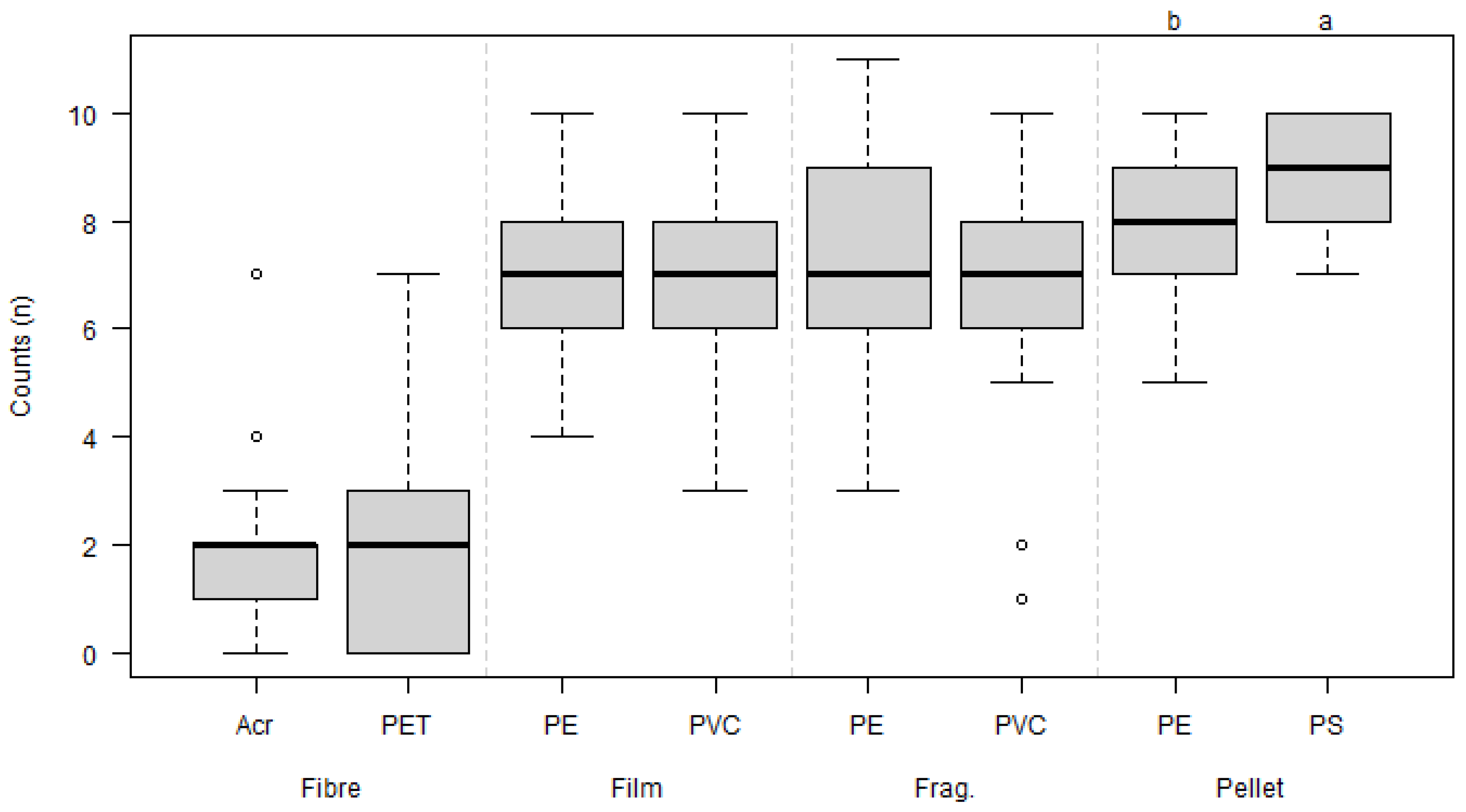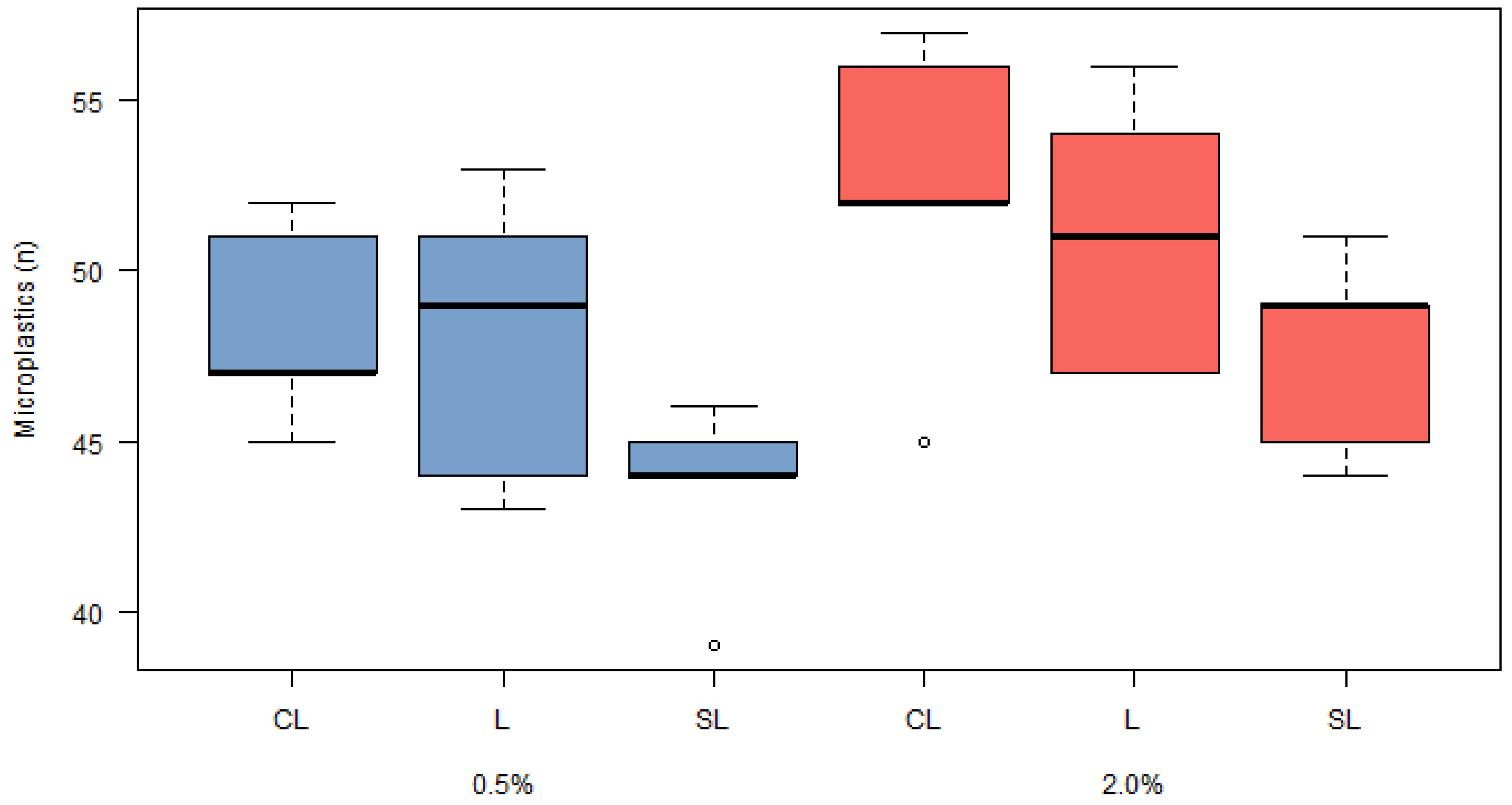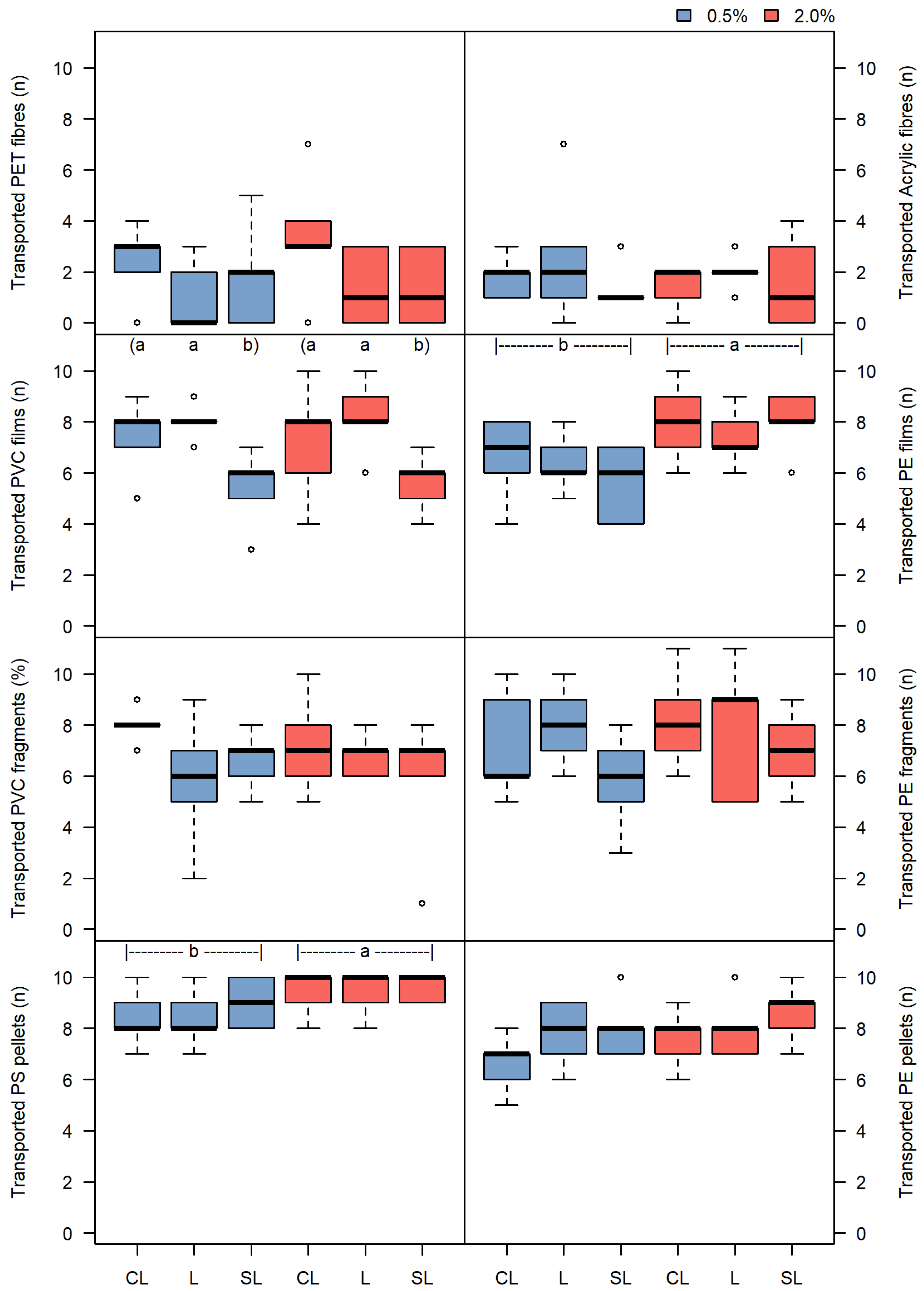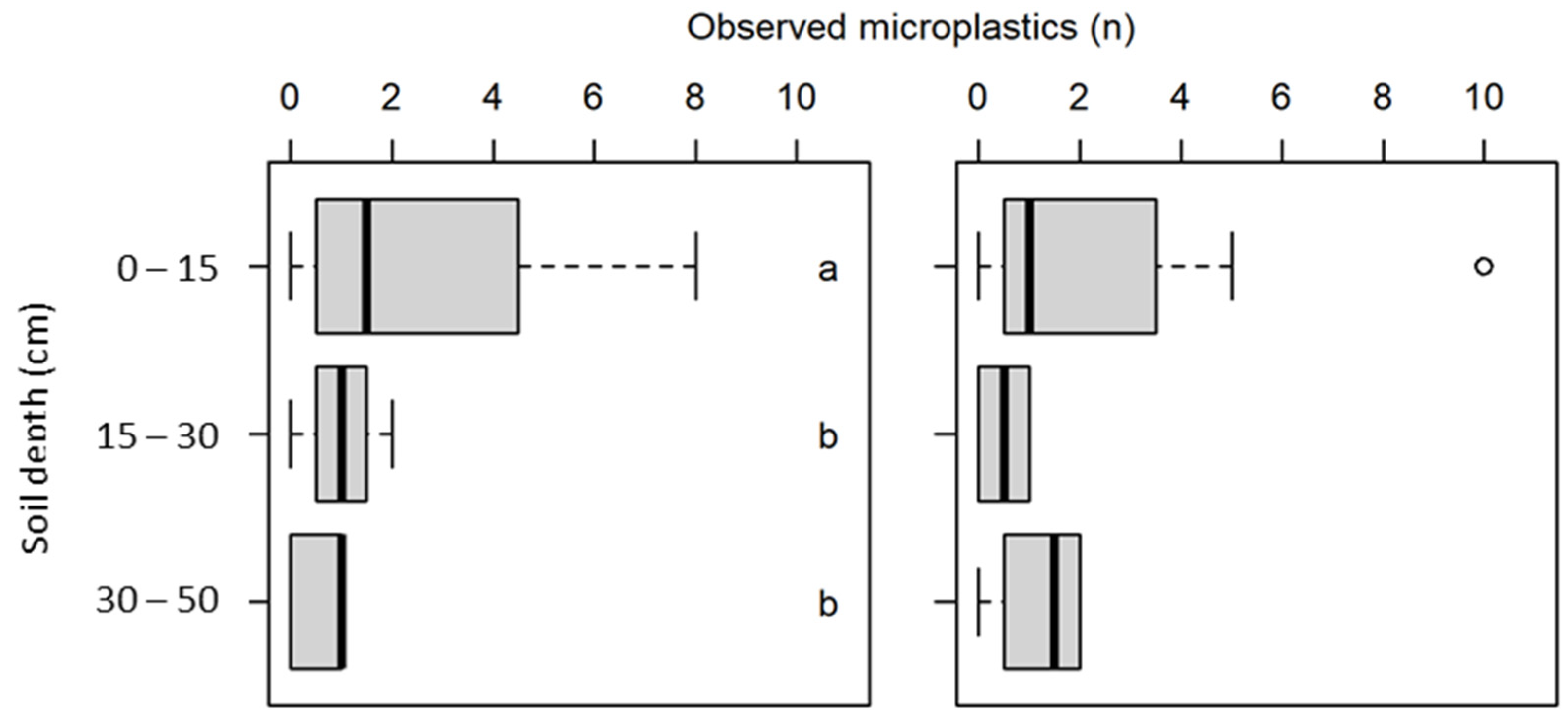Microplastic Transport by Overland Flow: Effects of Soil Texture and Slope Gradient Under Simulated Semi-Arid Conditions
Abstract
1. Introduction
2. Materials and Methods
2.1. Soil Flumes
2.2. Rain Simulation
2.3. Microplastics
2.4. Microplastic Recovery from the Collection Flasks
2.5. Field Survey and Soil Sampling
2.6. Soil Analysis for Microplastic Quantification
2.7. Experimental Design
2.8. Statistical Analysis
3. Results
3.1. Rain Simulation
3.1.1. The Effect of Polymer Type and Shape on Microplastic Transport
3.1.2. The Effect of Slope and Texture on Microplastic Transport
3.2. Field Observations
4. Discussion
5. Conclusions
Funding
Institutional Review Board Statement
Informed Consent Statement
Data Availability Statement
Conflicts of Interest
Abbreviations
| ACR | Acrylic (fibre) |
| PE | Polyethylene |
| PET | Polyethylene terephthalate |
| PS | Polystyrene |
| PVC | Polyvinyl chloride |
References
- Islam, T.; Cheng, H. Existence and fate of microplastics in terrestrial environment: A global fretfulness and abatement strategies. Sci. Total Environ. 2024, 953, 176163. [Google Scholar] [CrossRef] [PubMed]
- Iqbal, S.; Li, Y.; Xu, J.; Worthy, F.R.; Gui, H.; Faraj, T.K.; Jones, D.L.; Bu, D. Smallest microplastics intensify maize yield decline, soil processes and consequent global warming potential. J. Hazard. Mater. 2025, 486, 136993. [Google Scholar] [CrossRef] [PubMed]
- Siwach, S.; Bharti, M.; Yadav, S.; Dolkar, P.; Modeel, S.; Yadav, P.; Negi, T.; Negi, R.K. Unveiling the ecotoxicological impact of microplastics on organisms—The persistent organic pollutant (POP): A comprehensive review. J. Contam. Hydrol. 2024, 266, 104397. [Google Scholar] [CrossRef]
- Andrady, A.L. Microplastics in the marine environment. Mar. Pollut. Bull. 2011, 62, 1596–1605. [Google Scholar] [CrossRef]
- Zeng, H.; Cui, Y.; Shao, R.; Li, T.; Zhao, Y.; Liu, R.; Dai, Z.; Liu, Y.; Wang, J.; Xie, Q.; et al. Microplastics in animal-derived products and their potential risks to human health. TrAC Trends Anal. Chem. 2025, 185, 118187. [Google Scholar] [CrossRef]
- Sunil, S.; Bhagwat, G.; Vincent, S.G.T.; Palanisami, T. Microplastics and climate change: The global impacts of a tiny driver. Sci. Total Environ. 2024, 946, 174160. [Google Scholar] [CrossRef]
- Jiang, Y.; Yang, Y.; Zhan, C.; Cheng, B. Impacts of rainfall and lakeshore soil properties on microplastics in inland freshwater: A case study in Donghu Lake, China. Environ. Sci. Process. Impacts 2024, 26, 891–901. [Google Scholar] [CrossRef]
- Sharma, S.; Sharma, V.; Chatterjee, S. Contribution of plastic and microplastic to global climate change and their conjoining impacts on the environment—A review. Sci. Total Environ. 2023, 875, 162627. [Google Scholar] [CrossRef]
- Colmenarejo Calero, E.; Kovač Viršek, M.; Mali, N. Microplastics in Groundwater: Pathways, Occurrence, and Monitoring Challenges. Water 2024, 16, 1228. [Google Scholar] [CrossRef]
- Turner, A. Paint particles in the marine environment: An overlooked component of microplastics. Water Res. X 2021, 12, 100110. [Google Scholar] [CrossRef]
- Tziourrou, P.; Golia, E.E. Plastics in Agricultural and Urban Soils: Interactions with Plants, Micro-Organisms, Inorganic and Organic Pollutants: An Overview of Polyethylene (PE) Litter. Soil Syst. 2024, 8, 23. [Google Scholar] [CrossRef]
- Boonsong, P.; Ussawarujikulchai, A.; Prapagdee, B.; Pansak, W. Contamination of microplastics in greenhouse soil subjected to plastic mulching. Environ. Technol. Innov. 2025, 37, 103991. [Google Scholar] [CrossRef]
- Zhou, W.; Xu, J.; Fu, B.; Wu, Y.; Zhang, K.; Han, J.; Kong, J.; Ma, Y. Microplastic accumulation and transport in agricultural soils with long-term sewage sludge amendments. J. Hazard. Mater. 2024, 480, 136263. [Google Scholar] [CrossRef] [PubMed]
- Lwanga, E.H.; Beriot, N.; Corradini, F.; Silva, V.; Yang, X.; Baartman, J.; Rezaei, M.; van Schaik, L.; Riksen, M.; Geissen, V. Review of microplastic sources, transport pathways and correlations with other soil stressors: A journey from agricultural sites into the environment. Chem. Biol. Technol. Agric. 2022, 9, 20. [Google Scholar] [CrossRef]
- Sulaiman, M.S.; Anuar, S.T.; Ibrahim, Y.S.; Yusof, K.M.K.K.; Mohamad, Y.; Khalik, W.M.A.W.M.; Azmi, A.A.; Zainal Abidin, S.; Abdullah, N.S.; Yahya, N.K.E.M. Estimation of macroplastic yield from river basin to coastal area: A case study of the Klang River, Malaysia. Mar. Pollut. Bull. 2025, 212, 117527. [Google Scholar] [CrossRef]
- Du, A.; Hu, C.; Wang, X.; Zhao, Y.; Xia, W.; Dai, X.; Wang, L.; Zhang, S. Experimental Study on the Migration and Distribution of Microplastics in Desert Farmland Soil Under Drip Irrigation. Environ. Toxicol. Chem. 2024, 43, 1250–1259. [Google Scholar] [CrossRef]
- Kang, Q.; Zhang, K.; Dekker, S.C.; Mao, J. Microplastics in soils: A comprehensive review. Sci. Total Environ. 2025, 960, 178298. [Google Scholar] [CrossRef]
- Rieckhof, C.; Martínez-Hernández, V.; Holzbecher, E.; Meffe, R. Effect of particle size on the transport of polystyrene micro- and nanoplastic particles through quartz sand under unsaturated conditions. Environ. Pollut. 2024, 363, 125193. [Google Scholar] [CrossRef]
- Fu, Y.Z.; Yang, J.Y. Effects of Microplastics Migration on Farmland Soil Physical and Chemical Properties Under Leaching Conditions. Water Air Soil Pollut. 2025, 236, 40. [Google Scholar] [CrossRef]
- Liu, J.; Zheng, L. Microplastic migration and transformation pathways and exposure health risks. Environ. Pollut. 2025, 368, 125700. [Google Scholar] [CrossRef]
- Shachori, A.; Seginer, I. Sprinkling assembly for simulation of design storms as a means for erosion and runoff studies. Int. Assoc. Sci. Hydrology. Bull. 1962, 7, 57–72. [Google Scholar] [CrossRef]
- Shi, H.; Zheng, F.; Zhao, T.; Xu, X.; Liu, G. Impacts of straw mulching in longitudinal furrows on hillslope soil erosion and deposition in the Chinese Mollisol region. Soil Tillage Res. 2024, 243, 106178. [Google Scholar] [CrossRef]
- Cousins, A.; Dunn, C.; Aberg, D.; Smyth, A.J.; Williams, M.; Green, J.A.M.; Kurr, M. Evaluating microplastic trapping efficiency in seagrass meadows using hydraulic flume simulations. Mar. Pollut. Bull. 2025, 213, 117660. [Google Scholar] [CrossRef] [PubMed]
- Sahai, H.; Aguilera del Real, A.M.; Alcayde, A.; Bueno, M.J.M.; Wang, C.; Hernando, M.D.; Fernández- Alba, A.R. Key insights into microplastic pollution in agricultural soils: A comprehensive review of worldwide trends, sources, distribution, characteristics and analytical approaches. TrAC Trends Anal. Chem. 2025, 185, 118176. [Google Scholar] [CrossRef]
- Zhang, Y.; Wen, X.; Zhou, W.; Yang, Y.; Zhou, Z.; Chen, J.; Wang, X.; Wang, Y.; Tian, J.; Yuan, Y.; et al. Retention and migration of microplastics in stepped paddy fields: A study on microplastic dynamics in the special irrigation system. Environ. Res. 2025, 269, 120909. [Google Scholar] [CrossRef]
- Casanova, M.; Salazar, O.; Seguel, O.; Luzio, W. The Soils of Chile; Hartemink, A.E., Ed.; World Soils Book Series; Springer: Dordrecht, The Netherlands, 2013. [Google Scholar] [CrossRef]
- Verhaegen, T. The use of small flumes for the determination of soil erodibility. Earth Surf. Process. Landf. 1987, 12, 185–194. [Google Scholar] [CrossRef]
- Scholten, T.; Geißler, C.; Goc, J.; Kühn, P.; Wiegand, C. A new splash cup to measure the kinetic energy of rainfall. J. Plant Nutr. Soil Sci. 2011, 174, 596–601. [Google Scholar] [CrossRef]
- Kottek, M.; Grieser, J.; Beck, C.; Rudolf, B.; Rubel, F. World map of the Köppen-Geiger climate classification updated. Meteorol. Z. 2006, 15, 259–263. [Google Scholar] [CrossRef]
- Corradini, F.; Meza, P.; Eguiluz, R.; Casado, F.; Huerta-Lwanga, E.; Geissen, V. Evidence of microplastic accumulation in agricultural soils from sewage sludge disposal. Sci. Total Environ. 2019, 671, 411–420. [Google Scholar] [CrossRef]
- Berenstein, G.; Córdoba, P.; Díaz, Y.B.; González, N.; Ponce, M.B.; Montserrat, J.M. Macro, meso, micro and nanoplastics in horticultural soils in Argentina: Abundance, size distribution and fragmentation mechanism. Sci. Total Environ. 2024, 906, 167672. [Google Scholar] [CrossRef]
- Schneider, C.A.; Rasband, W.S.; Eliceiri, K.W. NIH Image to ImageJ: 25 years of image analysis. Nat. Methods 2012, 9, 671–675. [Google Scholar] [CrossRef] [PubMed]
- Soltani Tehrani, R.; Yang, X.; van Dam, J. Rainfall-induced microplastic fate and transport in unsaturated Dutch soils. J. Contam. Hydrol. 2025, 268, 104456. [Google Scholar] [CrossRef]
- Apte, S.; Dike, S.; Dabir, V. Vertical transport of HDPE microplastics through sandy and silty soil. Environ. Chall. 2024, 17, 101050. [Google Scholar] [CrossRef]
- Li, W.; Brunetti, G.; Zafiu, C.; Kunaschk, M.; Debreczeby, M.; Stumpp, C. Experimental and simulated microplastics transport in saturated natural sediments: Impact of grain size and particle size. J. Hazard. Mater. 2024, 468, 133772. [Google Scholar] [CrossRef]
- Moses, S.R.; Löder, M.G.J.; Herrmann, F.; Laforsch, C. Seasonal variations of microplastic pollution in the German River Weser. Sci. Total Environ. 2023, 902, 166463. [Google Scholar] [CrossRef]
- Li, F.; Huang, D.; Wang, G.; Cheng, M.; Chen, H.; Zhou, W.; Xiao, R.; Li, R.; Du, L.; Xu, W. Microplastics/nanoplastics in porous media: Key factors controlling their transport and retention behaviors. Sci. Total Environ. 2024, 926, 171658. [Google Scholar] [CrossRef] [PubMed]
- Han, N.; Zhao, Q.; Wu, C. Threshold migration conditions of (micro) plastics under the action of overland flow. Water Res. 2023, 242, 120253. [Google Scholar] [CrossRef]
- Harada, S.; Yajima, I.; Fukushima, K.; Nitta, Y. Retention, Degradation, and Runoff of Plastic-Coated Fertilizer Capsules in Paddy Fields in Fukushima and Miyagi Prefectures, Japan: Consistency of Capsule Degradation Behavior and Variations in Carbon Weight and Stable Carbon Isotope Abundance. Water 2024, 16, 1782. [Google Scholar] [CrossRef]
- Liu, D.; Yang, Z.; Gong, Y.; Song, D.; Chen, Y. Occurrence and emission characteristics of microplastics in agricultural surface runoff under different natural rainfall and short-term fertilizer application. J. Hazard. Mater. 2024, 477, 135254. [Google Scholar] [CrossRef]
- Schroers, S.; Eiff, O.; Kleidon, A.; Scherer, U.; Wienhöfer, J.; Zehe, E. Morphological controls on surface runoff: An interpretation of steady-state energy patterns, maximum power states and dissipation regimes within a thermodynamic framework. Hydrol. Earth Syst. Sci. 2022, 26, 3125–3150. [Google Scholar] [CrossRef]
- Katayama, A.; Nanko, K.; Jeong, S.; Kume, T.; Shinohara, Y.; Seitz, S. Short communication: Concentrated impacts by tree canopy drips—Hotspots of soil erosion in forests. Earth Surf. Dyn. 2023, 11, 1275–1282. [Google Scholar] [CrossRef]
- Cohen, N.; Radian, A. Microplastic Textile Fibers Accumulate in Sand and Are Potential Sources of Micro(nano)plastic Pollution. Environ. Sci. Technol. 2022, 56, 17635–17642. [Google Scholar] [CrossRef] [PubMed]
- Heinze, W.M.; Steinmetz, Z.; Klemmensen, N.D.R.; Vollertsen, J.; Cornelis, G. Vertical distribution of microplastics in an agricultural soil after long-term treatment with sewage sludge and mineral fertiliser. Environ. Pollut. 2024, 356, 124343. [Google Scholar] [CrossRef]
- Qiu, Y.; Niu, J.; Zhang, C.; Chen, L.; Su, B.; Zhou, S. Interpretable machine learning reveals transport of aged microplastics in porous media: Multiple factors co-effect. Water Res. 2025, 274, 123129. [Google Scholar] [CrossRef]
- Shafea, L.; Goebel, M.O.; Woche, S.K.; Peth, S. UV-ageing effects on polystyrene microplastics surface polarity and transport in soils. Environ. Chall. 2025, 18, 101080. [Google Scholar] [CrossRef]
- Kumar, R.; Verma, A.; Rakib, M.R.J.; Gupta, P.K.; Sharma, P.; Garg, A.; Girard, P.; Aminabhavi, T.M. Adsorptive behavior of micro(nano)plastics through biochar: Co-existence, consequences, and challenges in contaminated ecosystems. Sci. Total Environ. 2023, 856, 159097. [Google Scholar] [CrossRef]
- Corradini, F.; Melillán, E.; Schoebitz, M.; Carrasco, R.; Jiménez, M. Assessing on-site plastics fragmentation: Linking macroplastics litter to microplastics pollution in vegetable fields. Sci. Total Environ. 2024, 955, 177168. [Google Scholar] [CrossRef]





| Shape/Type | ACR | PE | PET | PS | PVC | Group Mean |
| Fibre | 1.8 ± 1.4 | - | 1.9 ± 1.8 | - | - | 1.9 ± 1.6 |
| Film | - | 7 ± 1.6 | - | - | 7.0 ± 1.8 | 7.0 ± 1.7 |
| Fragment | - | 7.3 ± 2.0 | - | - | 6.7 ± 1.9 | 7.0 ± 1.9 |
| Pellet | - | 7.8 ± 1.3 b | - | 9.0 ± 1.0 a | - | 8.4 ± 1.3 |
| Group mean | 1.8 ± 1.4 | 7.4 ± 1.6 | 1.9 ± 1.8 | 9.0 ± 1.0 | 6.8 ± 1.8 | 6.1 ± 3.0 |
Disclaimer/Publisher’s Note: The statements, opinions and data contained in all publications are solely those of the individual author(s) and contributor(s) and not of MDPI and/or the editor(s). MDPI and/or the editor(s) disclaim responsibility for any injury to people or property resulting from any ideas, methods, instructions or products referred to in the content. |
© 2025 by the author. Licensee MDPI, Basel, Switzerland. This article is an open access article distributed under the terms and conditions of the Creative Commons Attribution (CC BY) license (https://creativecommons.org/licenses/by/4.0/).
Share and Cite
Corradini, F. Microplastic Transport by Overland Flow: Effects of Soil Texture and Slope Gradient Under Simulated Semi-Arid Conditions. Soil Syst. 2025, 9, 40. https://doi.org/10.3390/soilsystems9020040
Corradini F. Microplastic Transport by Overland Flow: Effects of Soil Texture and Slope Gradient Under Simulated Semi-Arid Conditions. Soil Systems. 2025; 9(2):40. https://doi.org/10.3390/soilsystems9020040
Chicago/Turabian StyleCorradini, Fabio. 2025. "Microplastic Transport by Overland Flow: Effects of Soil Texture and Slope Gradient Under Simulated Semi-Arid Conditions" Soil Systems 9, no. 2: 40. https://doi.org/10.3390/soilsystems9020040
APA StyleCorradini, F. (2025). Microplastic Transport by Overland Flow: Effects of Soil Texture and Slope Gradient Under Simulated Semi-Arid Conditions. Soil Systems, 9(2), 40. https://doi.org/10.3390/soilsystems9020040






